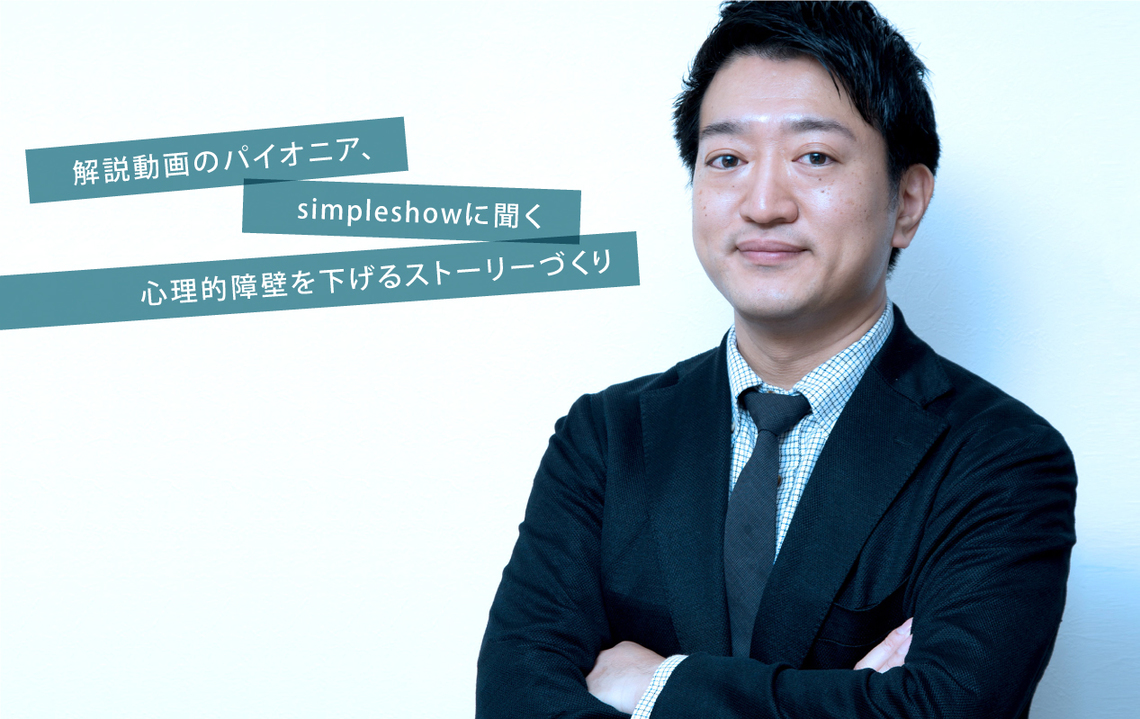Note: This website was automatically translated, so some terms or nuances may not be completely accurate.
The Power of Stories That Spark Empathy: Making It Personal What Are "Explanatory Videos" That Resonate with Viewers?

Tetsu Yoshida
simpleshow Japan Co., Ltd.
With mobile video viewing now commonplace, many companies are turning their attention to video-based communication. Among these, the genre gaining global recognition for its effectiveness is the "explainer video." While its use in Japan remains primarily for sales promotion, Tetsu Yoshida, CEO of simpleshow Japan, a pioneer in this field, states, "It actually delivers the highest impact in internal communication."

Explainer Videos: Conveying Complex Topics as Intended
——2014 is often called the "Year One of Video," and video-based marketing techniques are becoming established. Within this landscape, Germany's simpleshow, which pioneered the explainer video genre and opened up the market ahead of competitors, is now making a full-scale entry into Japan as its ninth country of operation. Mr. Tetsu Yoshida, CEO of their Japanese subsidiary, could you first explain what these "explainer videos" are?
Yoshida: "Explainer videos," known as "explainer videos" in English, have established themselves as a distinct genre separate from typical TV commercials or entertainment content videos. It's a new business domain that has developed over the past six or seven years.
For example, videos explaining how to use something while physically holding it, like in-flight safety videos, have existed for a while. However, simpleshow's explainer videos are slightly different. They structure complex topics into understandable, relatable stories. The key factor influencing their quality lies less in visual expression and more in storytelling that promotes intuitive understanding. Therefore, at simpleshow, we focus on human psychology, conducting extensive research and accumulating expertise.
——In what kinds of scenarios are they primarily used?
Yoshida: There are two main usage scenarios: external marketing, represented by e-commerce and sales presentations, and internal marketing, such as information sharing within the company or with partners, or e-learning.
For external use, it's most commonly employed as a promotional tool. It excels at conveying complex topics clearly in just a few minutes, making it ideal for explaining sophisticated, difficult information. It's particularly well-suited for B2B communication.
For example, if a pharmaceutical company tries to explain a new drug using thick brochures, busy doctors won't read them on the spot, and even if left behind, there's no guarantee they'll be reviewed. Furthermore, with paper materials, people tend to skim only the parts they want to read, making it difficult to convey the intended message effectively. To communicate concisely and precisely as intended, having them watch a 2-3 minute explanatory video on the spot is extremely effective.
While viewing an explanatory video rarely leads to an immediate purchase, it excels at creating opportunities. It captures the target audience's interest and makes them more receptive to subsequent detailed explanations, dramatically reducing the sales time required to close a deal.
Furthermore, they are frequently used in areas where live-action explanations are difficult, regardless of whether it's B2B or B2C. Considering the medical example earlier, recreating surgical scenes in live-action comes with expressive limitations. They are also well-suited for topics lacking physical objects or that cannot be filmed, such as IT, finance, law, policy, or situations requiring the communication of concepts.
Effective for training staff across countries in global enterprises
——It's used across an incredibly wide range of genres. How is it utilized for internal purposes?
Yoshida: For sharing information and training with internal staff and sales agents. Since simpleshow animates our original illustrations, it's easy to deploy across languages—just dub the narration. Since our company imposes no usage period restrictions or secondary use regulations once delivered, it's particularly popular among global corporations for various internal communications. Examples include new product sales training for sales staff, onboarding manuals for mid-career hires, and labor education for factory workers.We feel that streamlining internal information sharing and training is an immediate challenge for Japanese companies. Explanatory videos are especially effective for companies expanding overseas and employing a global workforce. While usage examples remain limited in Japan, establishing simpleshow Japan was partly motivated by our desire to support this area.
The internal use of explanatory videos has changed significantly in recent years. Even field staff working in stores or factories without dedicated computers can now connect to the internet via their smartphones, enabling internal communication through video. We thoroughly test the visibility of our videos on small smartphone screens and produce them based on this expertise.
——So demand is likely to grow in Japan too.
Yoshida: That's right. Like Germans, Japanese people are diligent, so they meticulously prepare materials even for internal use. However, relying solely on text or slide information tends to make people passive. To ensure companies effectively embed their messages with employees, communication methods need to evolve further. This applies not only to internal communication but also to scenarios like recruitment activities.
In Europe and the US, many companies already combine explanatory videos with comprehension tests for staff evaluations and personnel assignments, demonstrating proven effectiveness in knowledge and information retention. I believe Japanese companies conducting internal assessments could further enhance learning outcomes by integrating explanatory videos into their e-learning programs.
Stories that evoke empathy encourage personalization

——What's crucial for conveying complex topics that are hard to grasp through text alone?
Yoshida: Storytelling is key. At simpleshow, we prioritize narrative construction above all else. That's why we have dedicated scriptwriters on staff.
Our slogan is "From Why to How." Typically, product introduction videos start by explaining the features of a new product—the conclusion. But without first establishing "why" it's needed—sharing the challenge—in the introduction, people can't emotionally connect with the story.
For example, Renishaw, a UK measurement equipment manufacturer, used our explanatory video for their "REVO" product presentation ( http://simpleshow.com/jp/use-cases/revo/ ). In this video, the first minute of the three-minute clip is dedicated to sharing the challenge faced by the protagonist, Mr. Brown. Only after learning about REVO's features does the viewer truly grasp "why REVO is necessary for him." It transforms the story from someone else's problem into something viewers can personally relate to.
As a result, the psychological barrier clients feel toward REVO decreases, significantly shortening the time to close the deal. Explanatory videos are widely used as sales promotion tools precisely because they boost sales efficiency. In B2B scenarios, where securing a supervisor's approval is often necessary for purchase, these intuitively understandable videos also prove effective in facilitating communication within the client company. In fact, the REVO introduction video featured a client's supervisor character appearing toward the end.
——So the key is the ability to craft relatable stories.
Yoshida: Yes. At the core of simpleshow is the perspective of "how to generate empathy." While the illustration style or the technique of hands animating the drawings on screen might be imitable, an explanatory video won't function without a story structure that generates empathy. In that regard, we take pride in our advanced expertise—specifically, simpleshow's unique framework. Leveraging the know-how accumulated from producing over 4,000 explanatory videos, we listen to the client's challenges and transform them into the optimal story.
——Is the approach the same for B2B applications?
Yoshida: B2B especially requires relatable stories. Communication between experts tends to be stiff and tedious, and most stakeholders don't find that effective. Furthermore, since B2B often ultimately impacts end consumers, there's also a need to build narratives from a B2B2C perspective. This aligns with current advertising standards—it's essential to first convey why the target audience needs it and provide context that makes them feel personally invested.
Achieving high quality based on unique know-how
——What specific presentation aspects are key points?
Yoshida: For example, if intricate illustrations or photos are inserted into simple monochrome animation, it creates uneven visual information. The brain perceives this as foreign noise. As a result, viewers struggle to focus on the most important element: the story. The childlike illustrations we use deliberately reduce information density. This encourages viewers to understand instantly and naturally, enhancing the story's memorability. By illustrating corporate logos and products, they blend naturally into the story, preventing viewers from feeling like they're being sold to.
Conversely, we sometimes intentionally provide organic stimulation to the brain—like showing an illustration's shadow or leaving behind a partially swept-out illustration during scene transitions without editing it out. The exquisite blend of reducing stimulation and providing stimulation is our secret recipe.
BGM and sound effects are also kept to the absolute minimum to maximize their impact. You might not notice unless pointed out, but the BGM builds intensity when the solution to a problem appears midway through. Currently, jazz is used, but depending on the results of empirical testing, switching to different music in the future is being considered. Sound effects are also developed in-house, with over 3,000 types created while verifying whether they effectively convey the meaning of the illustrations.
Additionally, while the hand movements appear simple, they are actually meticulously calculated. When something is pointed at with a finger, people naturally focus on it. Since looking at another person's hand is an instinctive reaction, we leverage this to help users remember important topics and add dramatic tension to scene transitions.

——Is that nuanced approach handled by creators in each country?
Yoshida: No, it's perfectly systematized. At the "Simple Show Academy"—a think tank and educational institution at our German headquarters—we collaborate with partner universities and various organizations to research psychological transformation and comprehension levels. Based on this research, we incorporate effective techniques into manuals and share them with production teams worldwide. In addition to twice-weekly Skype video conferences, each job role is required to complete e-learning modules. Naturally, production teams in each country are also encouraged to actively propose "good ideas that could be standardized."
Although the Japanese subsidiary only began operations last spring, just one year ago, we have thoroughly pursued efforts to maintain the same production quality as Germany. Beyond individuals learning through simpleshow's common e-learning and video conferences, this includes headquarters reviews of works in progress, and visits by Academy representatives and creative leaders to Japan to provide "oral transmission" of know-how not found in manuals. Germany, the land of masters, excels at creating systems for craftsmen, but I truly believe simpleshow's educational system is outstanding.
——Finally, could you share your expectations for expansion in Japan?
Yoshida: The potential of explainer videos extends far beyond what's commonly recognized in the marketing industry. A recent overseas case that often surprises people is the use of simpleshow for Mercedes-Benz's luxury model, the Maybach. While high-end TV commercials are certainly necessary, there's also a growing need to adapt creative approaches for users whose lives revolve around smartphones. I believe we'll see a surge in Japan of a combined strategy: using TV's reach to boost brand awareness while simultaneously leveraging explanation videos—meticulously designed for smartphone viewing—to communicate the appeal that commercials alone cannot convey, thereby enhancing inbound effects. Furthermore, the trend seen in Europe and America where HR and corporate departments utilize explanation videos for information sharing among group employees and e-learning will undoubtedly spread here within the next few years.
We aim to further invigorate communication in Japan by proposing explanatory videos that lower psychological barriers for various internal and external scenarios.
Was this article helpful?
Newsletter registration is here
We select and publish important news every day
For inquiries about this article
Author

Tetsu Yoshida
simpleshow Japan Co., Ltd.
President and CEO
Born in 1973. Graduated from Tokyo Metropolitan Nishi High School, Keio University Faculty of Letters, and Keio University Media Communication Research Institute. After working at TV Tokyo and Dentsu Inc., joined simpleshow, which operated in 8 countries worldwide. Led the launch of the Japan subsidiary, the first in a non-English-speaking region, and became CEO of simpleshow Japan in 2014. Solves complex client challenges across Asia daily using the explanatory video methodology developed in Germany. <a href="http://simpleshow.com/">http://simpleshow.com/</a>